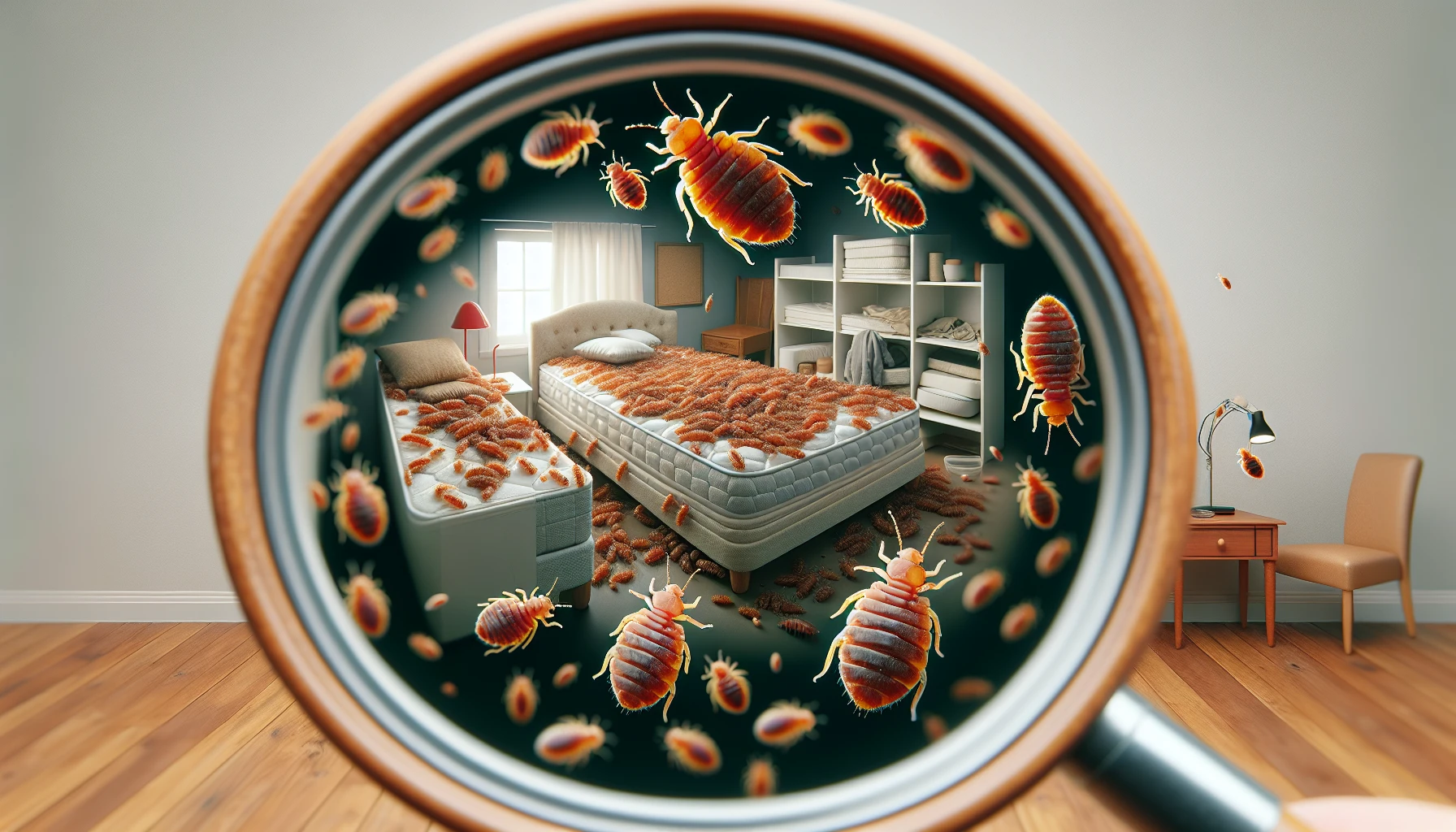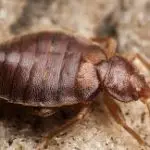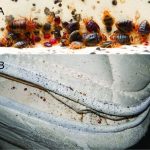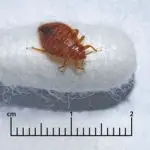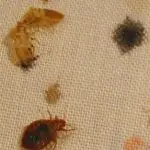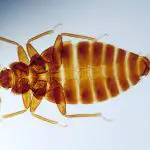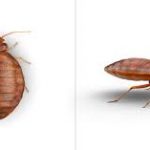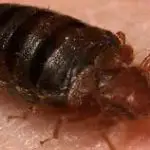Baby Bed Bugs Exposed: How to Spot and Stop Them Early
Understanding Baby Bed Bugs
Welcome to the tiny world under the sheets – a place where baby bed bugs lurk and grow, unbeknownst to the sleeping giants above. You might think they’re too small to spot, but knowing their disguises and hangouts is key to stopping these critters in their baby tracks. Let’s zoom in on what baby bed bugs are, unfold their life story, and highlight the differences between these mini-monsters and their full-grown counterparts.
Baby bed bugs, or nymphs, begin their lives as mere specks. At first glance, you’d mistake them for a dot of pepper or a fleck of dust. However, after their first blood meal, they reveal their true colors: from translucent to a more conspicuous reddish-brown. Imagine a critter the size of an apple seed dining on you without paying rent!

Surprisingly, baby bed bugs have quite the appetite. They can consume up to three times their weight in blood and grow rapidly, shedding their skin like tiny escape artists. Coupled with their cryptic behavior, this growth spurt allows them to spread quickly throughout a residence – a truly shudder-worthy notion!
It’s fascinating and somewhat terrifying how these infants feed. They’re like little vampires, creeping out in the dead of night, guided by the carbon dioxide we exhale to find their next meal – us! You might not feel them bite, but they leave behind itchy, red marks as souvenirs of their visit. Some have described awakening to a constellation of bites arrayed across exposed skin – not exactly the stargazing experience one hopes for.
To see these elusive creatures up close, you might consider checking out this resource for a visual tour of baby bed bug identification. It’s like a mini safari adventure without having to step foot outside your bedroom. Remember, spotting them early is crucial for keeping your sleeping sanctuary safe.
Better yet, don’t just stop at being a bed bug spectator. Why not become a bed bug preventer? Here’s a guide to early signs of bed bug presence in your home, helping you take proactive measures to avoid an infestation. Knowledge is power, and in this case, it’s the power to sleep tight without letting the bed bugs bite!
Lifecycle and Development Phases
Imagine a tiny, almost invisible assassin lurking in your bedroom, ready to feast and grow undetected. That’s the beginning of a bed bug’s life – an egg so small, most of us wouldn’t even see it without a magnifying glass. Bed bugs follow a development journey that’s both fascinating and a little creepy, but knowing about it is the first step to stopping these critters in their tracks.
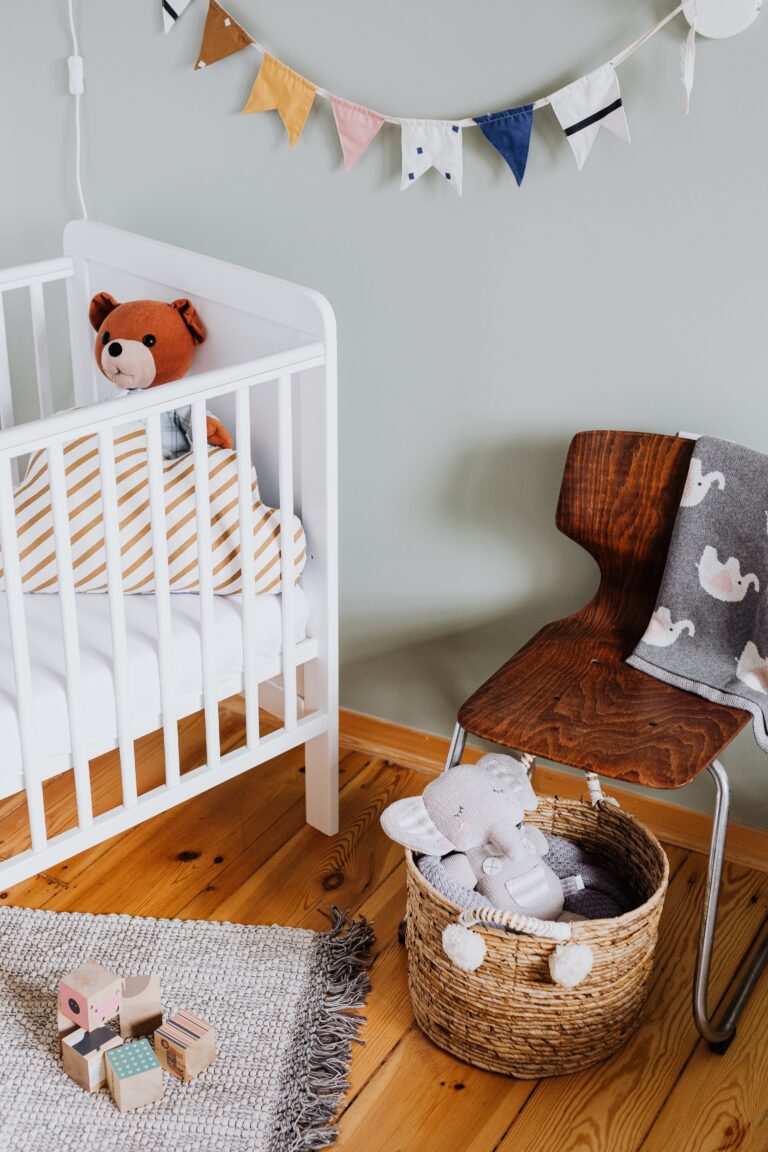
Let’s kick things off with the eggs. Pearly and roughly the size of a pinhead, these are the bed bug world’s equivalent to a newborn, and they hatch within one to two weeks. Fast forward, and you’ll meet nymphs – juvenile bed bugs that undergo five molts before reaching maturity. With each molt, they require a blood meal, and this is where you come in… or rather, your blood does.
What’s remarkable is that these tiny vampires can go months between meals in cooler climates. Imagine that—an insect biding its time, plotting its next move. Now, before you break into a sweat, it’s important to dig deeper into their growth stages and timeframes for development. A nymph’s journey to an adult bed bug typically spans around five weeks, but this can vary wildly depending on conditions like temperature and food supply.
A closer look at these immature bed bugs can help with early detection, one of your best defenses. These rascals can be sneaky, but they aren’t invisible. They grow from translucent whispers to rusty brown adults – a transformation you can stop if you’re vigilant.
If you’re not a fan of uninvited house guests, especially of the six-legged variety, heed the wise advice on bed bug infestation prevention. With regular inspection and speedy intervention, you can prevent the horror of a full-grown bed bug party under your sheets. Remember, knowledge is power, especially when it comes to pests. Armed with this understanding of their lifecycle, you’re better equipped to spot and stop baby bed bugs before they become the bane of your existence.
Initial Indications of Baby Bed Bug Presence
Imagine cozying up in your bed, the fabric soft against your skin, the pillows cradling your head, and the quiet whisper of the night lulling you into a peaceful slumber. Now, picture awakening to a skin-crawling reality: a baby bed bug staring right back at you. It’s a scenario no one wants to experience, yet it’s crucial to be vigilant about the early signs of these tiny intruders. They’re sneaky, they’re hungry, and they’re coming for your comfort zone.
One of the telltale signs that baby bed bugs are taking over your sacred space is the appearance of mysterious bites on your skin. These aren’t your average mosquito nips; we’re talking about small, red, and often lined-up bites that itch like there’s no tomorrow. It’s like they’re playing connect-the-dots on your body, each bite a potential sign that bed bugs are calling your mattress “home.”
But it doesn’t stop at itchy welts. You might notice strange, rusty spots on your mattresses and linens. These blemishes are the bed bugs’ calling cards, a mix of their excrement and your dried blood – a tainting of your bed’s purity by these uninvited guests. And don’t be deceived by their size; what baby bed bugs lack in stature, they make up for in sheer audacity. These diminutive pests, resembling a speck of dirt or a tiny apple seed, have grand aspirations of infesting your abode.

Addressing an infestation in its infancy is paramount; early detection can save you from a full-blown bed bug battle. But how do you catch them before they grow up and invite their cousins over? Keep a discerning eye on your bed and bedroom for these mini marauders. A magnifying glass might just become your new best friend in spotting these tiny nuisances before they balloon into a full-fledged infestation.
Fortunately, there’s a silver lining in the form of proactive measures and strategies you can learn to keep these pests at bay. Understanding the enemy is the first step towards reclaiming your peaceful nights and ensuring that the only thing tucked in your bed is you, not a colony of bloodthirsty bed bugs.
Stay informed, stay observant, and most importantly, stay un-bitten. With keen observation and actionable knowledge, you can stop these baby bed bugs in their tracks – because your bed should be a haven, not a bug buffet.
Potential Health Risks
An often under-discussed but critical aspect of home invasions by pests is the health risks they bring to the table—or should we say, to the bed? Yes, we’re talking about those minuscule marauders: baby bed bugs. While the adult bed bugs get most of the infamy, their juveniles—innocuous as they might seem—are also carriers of distress, not just for our peace of mind but for our physical well-being too.
Have you ever woken up to a constellation of itchy, red welts tracing your skin? That’s the handiwork of baby bed bugs. These bites might seem benign at first—after all, a little hydrocortisone, a dab of calamine, and you’re as good as new, right? Wrong. The potential health implications of these bites range from mild allergic reactions that cause discomfort and disrupt your beauty sleep, to more severe, systemic reactions in some individuals.
Imagine little Suzie, just five, with her immune system still developing, becoming an all-you-can-eat buffet for a troupe of baby bed bugs. An innocent nap can turn into a night terror, as her delicate skin reacts with rashes that could lead to secondary infections from the incessant scratching. These uninvited guests don’t discriminate; they equally pose risks to every member of your household, whether they walk on two legs or four.
Apart from the physical tribulations, these critters can also be responsible for psychological stress. Ever tried closing your eyes and drifting off to sleep with the gnawing thought of microscopic vampires in your mattress? No lullabies can put that worry to sleep. It’s a psychological itch that’s hard to scratch, leading to potential sleep deprivation and the cascading health issues that come with it.
And let’s not forget, where there are bugs, there might be bug spray, right? Chemical treatments to eradicate them could further pollute your safe space, introducing toxins that could have long-term ramifications on your health.

In short, these not-so-cuddly bedfellows, despite their diminutive size, pose risks that are nothing short of substantial. Recognizing early signs of baby bed bug infestations and taking swift, safe actions to deal with them can help you maintain not just a tranquil bedroom but a healthy, happy home.
Proactive Prevention Methods
When it comes to outsmarting baby bed bugs, the adage “an ounce of prevention is worth a pound of cure” couldn’t ring more true. To keep these tiny trespassers at bay, let’s dive into some tried-and-true strategies that will keep your living space blissfully bug-free. First off, a keen eye and regular inspections are your best friends. Think of it like a game of hide and seek, where you’re always on the winning side. Check the nooks, crannies, and all those cozy spots that bed bugs love to call home—like mattresses, bed frames, and box springs.

Imagine this: It’s a lazy Sunday, and you decide to spring into action with a cleanliness overhaul. You’re vacuuming away, and lo and behold, you might just suck away some unwanted guests. Regular cleaning doesn’t just keep your space sparkling, it’s also a top-tier tactic in the fight against bed bug infestations. And, while we’re on the subject of cleanliness, let’s talk about your sheets, covers, and clothes. Toss them in the wash at a high temperature, and bed bugs will have a meltdown—literally. Because, just like ice cream on a hot day, baby bed bugs can’t withstand the heat.
Now, here’s a scenario for you: Your friend returns from a globetrotting adventure with a suitcase full of souvenirs and—unbeknownst to them—stowaway bed bugs. Before you know it, your home’s become a free B&B for bugs! To sidestep such a scenario, encourage vigilance among your visitors. Luggage should be stored away from bedrooms and inspected post-travel. Think of it as border control for bugs—no passport, no entry!
Lastly, if you’ve ever had a yard sale steal or scored an unbeatable bargain on some antique furniture, pat yourself on the back for your thriftiness—but also remember to inspect your new treasures before they cross your threshold. These pre-loved items might come with a hidden cost if they’re harboring baby bed bugs looking for a new place to crash.
By adopting these proactive prevention methods, you’re setting up a fortress against baby bed bugs. Stay vigilant, keep cleaning regularly, and inspect everything from luggage to second-hand furniture, and you’ll be well on your way to maintaining a peaceful, pest-free home.
Effective Home Remedies and Solutions
Discovering baby bed bugs lurking around your sacred sleeping space can send shivers down the spine of any homeowner. But before panic sets in, take a deep breath—we’re about to arm you with an arsenal of home remedies that can help you nip the problem in the bud, pun intended.
Picture this: You’re changing the bedding, and there they are—tiny, elusive critters that have been feasting unnoticed. Don’t let their size fool you; these immature nuisances can escalate into a full-blown infestation faster than a toddler makes a toy mess! But fear not, with some strategic moves, you can turn the tide in your favor.
DIY Detection: Play Detective
First up, let’s talk detection. Baby bed bugs, or nymphs, are tricky to spot with their translucent bodies. Grab a magnifying glass and a flashlight, and scout for signs like tiny blood spots or minuscule exoskeletons on your sheets. Early identification is half the battle won!

Home Mixtures: Nature’s Insecticides
Now, let’s stir up some trouble for these pests—literally. You can create potent concoctions using everyday household items. A favorite is a blend of water and essential oils like lavender or peppermint. These oils have insect-repelling properties that bugs despise. Spray generously around potential hotspots and enjoy the fresh scent as a bonus.
Ever heard of diatomaceous earth? It’s a natural, harmless powder to humans and pets but lethal to bed bugs. Sprinkle it around your bed frame, and let this natural marvel do the rest. Just remember to use food-grade diatomaceous earth to keep it safe for the household.
The Heat is On: Steam Your Troubles Away
A steam cleaner can be your best friend when battling bed bugs. These pests can’t withstand high temperatures, so give them a steamy surprise. Focus on seams of mattresses, crevices in the bed frame, and any area that looks like a good hiding spot. Not only will the heat zap the bugs, but it’ll also sanitize your sleeping area—sweet dreams indeed!
In conclusion, not all invaders require professional exterminators or harsh chemicals. Sometimes, the solution lies within the humble confines of your home. Armed with these tips and vigilance, baby bed bugs won’t stand a chance. So, take action, reclaim your peace of mind, and ensure your bed is a sanctuary, not a snack bar for unwanted guests.
Professional Extermination Options
Have you woken up with itchy, red bites and found tiny invaders in your bed? You could be facing an outright blitz from baby bed bugs. But when are home remedies not enough? Let’s dig into the nitty-gritty of when to bring in the big guns—
Recognizing the Sirens of Infestation
Imagine this—you’re changing your sheets and there they are: miniature pests that could turn your serene sanctuary into a nightmare nook. When you spot these critters, whether they’re babies or full-blown adults, it’s a red flag. Sure, you can vacuum your heart out or try DIY treatments, but these measures are often band-aids on a potentially spreading wound.
Why Call the Pros?
Professionals in pest extermination bring tools and expertise that go far beyond your average insect spray. They’re the Navy SEALs in the battle against bed bugs, equipped with knowledge and artillery to root out the problem from its core. When you reach the point where you’re spotting baby bed bugs frequently, it’s time for professional intervention.
The Extermination Armory
Exterminators might use a variety of strategies to ensure your bed bug woes are squashed. There’s the tried-and-true chemical treatment, which involves pesticides that are lethal for bed bugs at all life stages. Then there’s heat treatment, turning your home into a sauna that’s too hot to handle for these pests. And let’s not forget about cryonite freezing, where bed bugs are sent to a frosty demise. The right method depends on your unique invasion.

Real-life Bed Bug Busts
Take the case of the Jones family, who tried every spray in the aisle before finally calling an exterminator. Post-treatment, they’ve reclaimed their home and sanity. Or consider the Harrison apartment complex, where a systematic extermination plan across multiple units wiped out an infestation that threatened to overrun the building.
Choosing Your Battle Plan
It’s all about strategy. Meet with a licensed exterminator to discuss the history and scope of your infestation. They’ll craft a personalized plan, often combining multiple treatment types to ensure those baby bed bugs don’t stand a chance.
You want to nip the problem in the bud before it escalates. Once it’s clear that home remedies aren’t cutting it, it’s time to bring in the professionals. They’re your ticket to a bug-free haven, letting you sleep tight without letting the bed bugs bite!
Post-Treatment: Ensuring They Don’t Return
Alright, you’ve won the battle against baby bed bugs, but the war isn’t over yet! It’s time to fortify your home’s defenses and make sure these tiny pests don’t stage a comeback. Let’s talk about the crucial steps to take post-treatment to keep your sanctuary safe.
First thing’s first: regular inspections are your new best friend. Just like checking your car’s oil, giving your home a thorough look-over at strategic spots can save you a ton of hassle later on. Take a flashlight and go over seams of mattresses, couch crevices, and even behind picture frames—anywhere those crafty critters might lurk.
Imagine this: It’s a serene Sunday morning, you’re sipping your coffee, and you decide to peek under your child’s mattress. Lo and behold, you spot something suspicious. Because you’ve been diligently checking, it’s just one or two stray bugs, and you can deal with them swiftly—crisis averted!
Now, let’s talk about your mattress. It’s like a five-star resort for bed bugs, so it’s time to ruin their vacation. Invest in a high-quality mattress encasement. Much like a superhero’s shield, it keeps your mattress safe and stops bed bugs from setting up camp in there—ever again.
Let’s not forget, knowledge is power. By understanding the signs of a potential re-infestation, such as tiny blood spots or shed skins, you’ll be ready to act faster than a superhero spotting a cry for help.

Remember, it’s about being proactive, not reactive. Think of these steps as your home’s ongoing security protocol. By keeping up with inspections and using protective encasements, you’re taking the ‘pest’ out of ‘persistent.’ Stay vigilant, and you’ll keep those baby bed bugs at bay for good.
Frequently Asked Questions
When it comes to baby bed bugs, understanding the nuances can make all the difference in early detection and prevention. Have you ever wondered just how tiny these pint-sized pests are or whether they’re responsible for that mysterious bite? Let’s dive into the details and leave no question unanswered with real-world insights.
How Small Are Baby Bed Bugs?
Imagine the tip of a ballpoint pen – that’s roughly the size of baby bed bugs, or nymphs, to give them their proper name. These miniatures of the insect world start life at around 1mm long. It’s no wonder they often escape notice, leading to an unwelcome surprise of an established infestation later on.

Can Baby Bed Bugs Bite?
While they may be small, they’re certainly mighty when it comes to their bite. Nymphs need a blood meal to advance to the next stage of their development, so yes, baby bed bugs do bite. And since they’re often more numerous than the adults, a population of baby bed bugs could mean increased bite activity.
How Quickly Do Baby Bed Bugs Spread?
Baby bed bugs can hitch a ride on clothing or luggage and can swiftly spread to new environments. Their spread is often tied to human activity – the more we move, the more they move. And once they settle in, they waste no time multiplying. In a female bug’s lifetime, she can lay hundreds of eggs, paving the way for rapid expansion if not promptly addressed.
What Do Baby Bed Bug Bites Look Like Compared to Other Insect Bites?
Often mistaken for mosquito or flea bites, baby bed bug bites have some tell-tale signs: they tend to appear in a line or cluster and might cause a burning sensation, followed by an itchy, raised welt. Unlike mosquito bites, they don’t begin to itch immediately, which can make early detection a bit tricky. Keep an eye out for these uninvited guests after you might have stayed at different places or brought second-hand furniture into your home.
Arming yourself with knowledge is a pivotal step to keeping your home free of baby bed bugs. Identifying them early on ensures that your peaceful sanctuary remains a no-bug zone and that your nights are blissfully bite-free!
